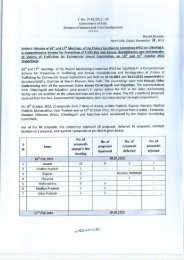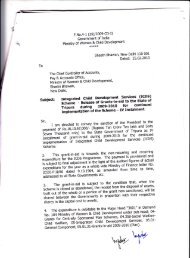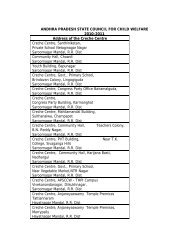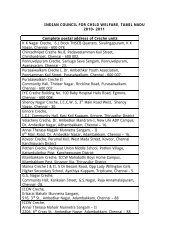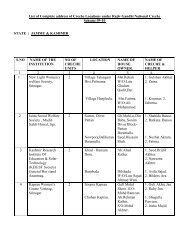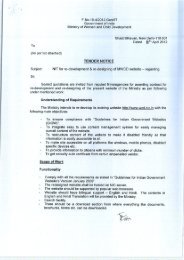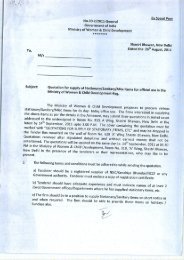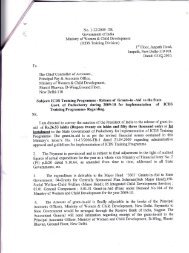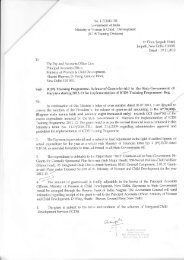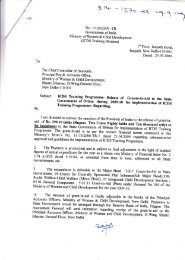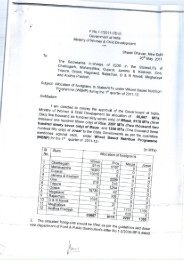COVER HINDI - Ministry of Women and Child Development
COVER HINDI - Ministry of Women and Child Development
COVER HINDI - Ministry of Women and Child Development
- TAGS
- hindi
- ministry
- wcd.nic.in
You also want an ePaper? Increase the reach of your titles
YUMPU automatically turns print PDFs into web optimized ePapers that Google loves.
Broad framework <strong>of</strong> activities<br />
6.14 The challenge <strong>of</strong> Gender Budgeting lies in<br />
translating stated policy commitments in to budgetary<br />
Constitutional Provisions<br />
Box - 2 :<br />
Policy Commitments for <strong>Women</strong><br />
allocations <strong>and</strong> outcomes. The commitments towards<br />
women are reflected in our Constitution, Policies <strong>and</strong> Plan<br />
documents (Box 2 <strong>and</strong> Box 3). Gender Budgeting lends<br />
itself to realizing the goals outlined therein.<br />
The commitment to gender equity is well entrenched at the highest policy making level- the Constitution <strong>of</strong><br />
India. A few important provisions for women are:<br />
• Article 14 – Equal Rights <strong>and</strong> Opportunities in Political Economic <strong>and</strong> Social Spheres<br />
• Article 15 – Prohibits discrimination on grounds <strong>of</strong> sex<br />
• Article 15(3) – Enables affirmative discrimination in favour <strong>of</strong> women<br />
• Article 39 – Equal means <strong>of</strong> livelihood <strong>and</strong> equal pay for equal work<br />
• Article 42 – Just <strong>and</strong> Humane conditions <strong>of</strong> work <strong>and</strong> maternity relief<br />
• Article 51(A)(e) – Fundamental Duty to renounce practices, derogatory to dignity <strong>of</strong> women<br />
The National Policy for Empowerment <strong>of</strong> <strong>Women</strong> 2001 envisaged introduction <strong>of</strong> a gender perspective in<br />
the budgeting process as a operational strategy.<br />
These provisions are effected <strong>and</strong> supplemented by the legal framework. A few laws <strong>and</strong> legislations are:<br />
<strong>Women</strong> specific Legislations<br />
• Immoral Traffic (Prevention) Act, 1956, •The Maternity Benefit Act, 1961,•The Dowry Prohibition Act, 1961<br />
• Indecent Representation <strong>of</strong> <strong>Women</strong> (Prohibition) Act, 1986,•The Commission <strong>of</strong> Sati (Prevention)Act, 1987,;<br />
Protection <strong>of</strong> <strong>Women</strong> from Domestic Violence Act, 2005<br />
Economic<br />
Factories Act, 1948, Minimum Wages Act, 1948, Equal Remuneration Act, 1976, The Employees’ State Insurance<br />
Act, 1948, The Plantation Labour Act, 1951, The Bonded Labour System (Abolition) Act, 1976<br />
Protection<br />
Relevant provisions <strong>of</strong> Code <strong>of</strong> Criminal Procedure, 1973; Special provisions under IPC, The Legal Practitioners<br />
(<strong>Women</strong>) Act, 1923, The Pre-Natal Diagnostic Technique (Regulation <strong>and</strong> Prevention <strong>of</strong> Misuse ) Act, 1994.<br />
Social<br />
Family Courts Act, 1984, The Indian Succession Act, 1925, The Medical Termination <strong>of</strong> Pregnancy Act, 1971,<br />
Prohibition <strong>of</strong> <strong>Child</strong> Marriage Act, 2006, The Hindu Marriage Act, 1955, The Hindu Succession Act, 1956 (&<br />
amended in 2005),The Indian Divorce Act, 1969<br />
98 Annual Report 2006-07



